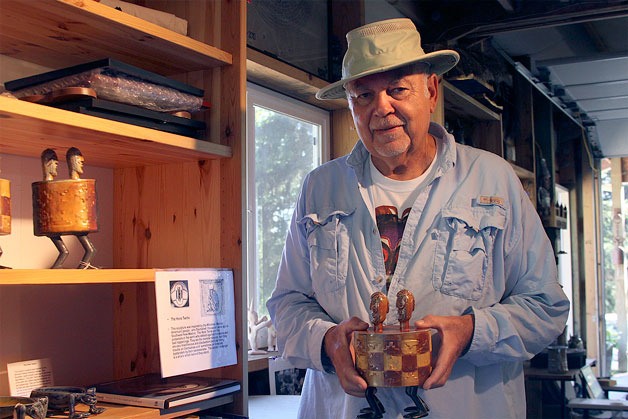The slightest rumble can make Jerry Pike feel a little uneasy.
Tucked away in the countryside of North Whidbey Island, Pike’s house and art studio are home not only to he and his wife, but also to an army of fragile clay figures, pots and masks.
The idea of a significant earthquake one day makes Pike shutter.
“I do think about it,” Pike said. “Almost once a week.
“Because these things are going to dive, right?”
Much of Pike’s life work are making faces at him for making such a suggestion. Or at least, it seems that way.
He’s always getting strange looks from the hundreds of creatures and masks he created — inspired by artifacts and sculptures of ancient and primitive cultures, particularly Northwest Coast and pre-Columbian civilizations.
Pike will be opening up this world to the public this weekend as part of the annual Whidbey Working Artists Summer Open Studio Tour.
On a self-guided tour of 37 studios representing 52 artists, his is arguably the most remote, located in the country near Strawberry Point.
While approaching on a dusty dirt road, you know you’re close when you’ve reached the “Sasquatch Crossing” sign.
He and his wife Brenda have never seen one of those creatures on their property, but she had an upclose encounter with Whidbey Island’s lone elk standing in their front yard.
“It was the biggest darn thing I’ve ever seen in my life,” she said. “I actually called 911. I didn’t know what to do.”
Startling features are the norm around their place. Some trees are decorated with primitive masks.

There’s a warrior in his garden fashioned from old sewer pipe. He doesn’t look particularly angry but should be. Jerry Pike shaped it by pounding it with a baseball bat.
Pike refers to himself as a “ceramic archaeologist.” He devours books and magazines about primitive cultures and studies the latest archaeological news. He’s traveled extensively to ancient sites in the American Southwest and Mexico and is mostly drawn to American Indian “power places hidden in the sacred mountains and mesas of the Southwest.”
His creations are often inspired by primitive cave drawings, recently published discoveries on archaeological digs or a unique custom about a primitive culture he learns about that either amuses or fascinates him.
“I will get hooked on something,” he said, “like these Venus figurines. It was National Geographic that got me into it.”

The figurines, so small they can be cupped in one’s hand, are inspired by the Upper Paleolithic statuettes, some more than 30,000 years old, that were uncovered in Europe. They portray women but often don’t contain heads or limbs.
He added heads on some.
Pike’s creations include frog salsa dishes, flying dog saucers, winged pots and spirit houses that can emit smoke rings.
He’s created larger sculptures of ancient Olmec warriors, the products of a more extensive wood-firings in kilns where temperatures can reach 2,000 degrees.
He’ll also use a western-style raku firing method where pieces are moved from a kiln at bright red heat and placed in a garbage can with combustable materials and the lid is placed on top. This method can help blacken raw clay or impact the color or amount of crackle in glaze.
“It’s a fun process,” Pike said.
He’s been at it for decades.
His interest in primitive cultures started when he was a kid growing up in Pullman and regularly accompanied his dad on fishing outings to the Snake River.
“He’d fish for steelhead, I’d look for artifacts,” Pike said.
At Pullman High School, he began dabbling with woodwork and carved his first primitive mask.
It joins hundreds of others on display in his studio, home and property, if you include his vast collection of miniature masks he’s made.
Among the larger masks are those of the sasquatch, a fascination also rooted to his early years, based on a tale from his father about enormous footprints he and his friends encountered on an elk hunting trip in the Blue Mountains near Walla Walla in the 1950s.
It was six months until his father spoke about it.
“It really fooled with them,” Pike said.
A retired lieutenant colonel in the Army and Vietnam veteran, Pike didn’t start playing with clay until the early 1970s. He became inspired by watching the Vietnamese do the craft during his time in the Mekong Delta.
After working as a consultant in organizational development while living in Sunnyvale, Calif., Pike and his wife retired to Whidbey Island.
Pike had visited Bainbridge Island when he was in college and was blown away by the beauty and began dreaming about one day returning to live on an island.
Once he found his paradise on Whidbey, he built his own art studio in the style of a pole barn, and it’s been one of his favorite hangouts ever since.
“He’s amazing,” said Brenda, also an artist on the island known for her vividly colored photograph prints.
She met him while working for a pharmaceutical company in northern California. The first time she came to his office, she was struck by his artwork.
“I was just mesmerized by it,” Brenda said, “because it’s a very primitive kind of art. It’s part of all of us. People take time to look at it.”
“They’re pretty much attracted to it because it’s in all of our DNA.”
Art studio tour
The Whidbey Working Artists Summer Open Studio Tour takes place from 10 a.m. to 5 p.m. Saturday, Aug. 27, and Sunday, Aug. 28. There are 37 stops on the self-guided free tour across the island. For a map and locations, go to www.whidbeyworkingartists.com and click “catalogue.”

